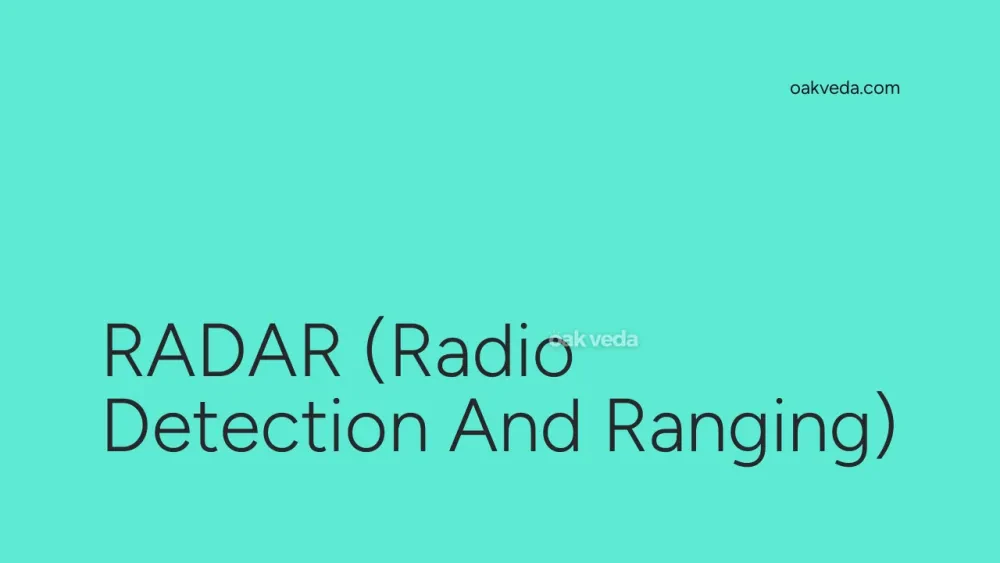
What is the Full Form of RADAR?
RADAR is an acronym with the full form "Radio Detection And Ranging." This technology has revolutionized various fields, from military operations to weather forecasting, by providing accurate detection and measurement of objects using radio waves.
What is Radio Detection And Ranging?
Radio Detection And Ranging, commonly known as RADAR, is an electronic system that uses radio waves to detect, locate, and track objects. It operates by emitting electromagnetic waves and analyzing the reflected signals to determine the position, speed, and sometimes even the shape of targets.
Origin and Development of RADAR
The concept of RADAR has its roots in the early 20th century, but it gained significant momentum during World War II. Several countries secretly developed RADAR technology for military purposes. The term "RADAR" was coined by the United States Navy in 1940, although the technology itself was being researched and developed by multiple nations simultaneously.
The evolution of RADAR has been continuous since its inception, with advancements in electronics, signal processing, and computer technology contributing to its improved capabilities and wider applications.
How does RADAR work?
The working principle of RADAR can be broken down into several key steps:
- Signal Transmission: The RADAR system emits high-frequency radio waves into the surrounding environment.
- Wave Propagation: These waves travel through the air at the speed of light.
- Object Interaction: When the waves encounter an object, they are scattered in various directions.
- Signal Reception: A portion of the scattered waves returns to the RADAR receiver.
- Signal Processing: The received signals are analyzed to extract information about the target.
- Data Interpretation: The processed data is used to determine the object's location, speed, and sometimes its size and shape.
Types of RADAR
RADAR systems can be classified based on various criteria:
- Continuous Wave (CW) RADAR: Emits signals continuously, ideal for measuring velocity.
- Pulsed RADAR: Transmits short pulses of radio waves, useful for range determination.
- Doppler RADAR: Utilizes the Doppler effect to measure target velocity accurately.
- Synthetic Aperture RADAR (SAR): Creates high-resolution images of ground targets.
- Phased Array RADAR: Uses multiple antennas to steer the beam electronically.
Functions of RADAR
RADAR systems perform several crucial functions:
- Detection: Identifying the presence of objects within the RADAR's range.
- Ranging: Measuring the distance to detected objects.
- Tracking: Following the movement of objects over time.
- Imaging: Creating visual representations of detected objects or terrain.
- Velocity Measurement: Determining the speed of moving targets.
Applications of RADAR
RADAR technology finds applications in numerous fields:
- Military: Used for air defense, missile guidance, and battlefield surveillance.
- Aviation: Assists in air traffic control, weather monitoring, and aircraft navigation.
- Maritime: Aids in ship navigation, collision avoidance, and port traffic management.
- Meteorology: Helps in weather forecasting and storm tracking.
- Law Enforcement: Used for speed detection in traffic control.
- Space Exploration: Facilitates tracking of satellites and spacecraft.
- Geology: Employed in mapping terrain and studying Earth's surface.
Features of RADAR
Modern RADAR systems boast several advanced features:
- High Resolution: Ability to distinguish between closely spaced targets.
- All-Weather Operation: Functionality in various atmospheric conditions.
- Long-Range Detection: Capability to detect objects at great distances.
- Multi-Target Tracking: Simultaneous tracking of multiple objects.
- Clutter Rejection: Filtering out unwanted echoes from the environment.
- Electronic Beam Steering: Rapid scanning without mechanical movement.
Benefits of RADAR
RADAR technology offers numerous advantages:
- All-Weather Capability: Operates effectively in fog, clouds, snow, and rain.
- Day and Night Operation: Functions regardless of lighting conditions.
- Long-Range Detection: Can detect objects at considerable distances.
- Accurate Measurements: Provides precise data on target location and velocity.
- Real-Time Information: Offers immediate feedback on detected objects.
- Non-Intrusive: Operates without physical contact with targets.
- Versatility: Applicable in various fields and environments.
Limitations or Challenges of RADAR
Despite its many advantages, RADAR technology faces some limitations:
- Signal Interference: Susceptible to electronic jamming and natural interference.
- Resolution Limitations: Difficulty in distinguishing very close objects.
- Terrain Masking: Ground clutter can obscure low-flying targets.
- Power Requirements: High-power consumption, especially for long-range systems.
- Size and Cost: Some RADAR systems can be large and expensive.
- Interpretation Complexity: Requires skilled operators to interpret RADAR data accurately.
Future Developments in RADAR Technology
The field of RADAR technology continues to evolve, with several exciting developments on the horizon:
- Cognitive RADAR: Systems that can learn and adapt to their environment.
- Quantum RADAR: Utilizing quantum entanglement for enhanced sensitivity.
- AI Integration: Incorporating artificial intelligence for improved target recognition.
- Miniaturization: Development of compact, low-power RADAR systems.
- Multi-Static RADAR: Networks of distributed RADAR sensors for improved coverage.
- Software-Defined RADAR: Flexible systems that can be reconfigured through software.
FAQs on RADAR Full Form
-
What does RADAR mean in full? RADAR's full form is Radio Detection And Ranging.
-
Who invented RADAR? RADAR was developed by multiple scientists and engineers across different countries, with significant contributions from Robert Watson-Watt, Heinrich Hertz, and Christian Hülsmeyer.
-
Can RADAR see through walls? Traditional RADAR cannot penetrate solid walls, but specialized through-wall RADAR systems have been developed for specific applications.
-
How accurate is RADAR? Modern RADAR systems can be highly accurate, with some capable of measuring distances within a few centimeters and velocities within fractions of a meter per second.
-
Is RADAR harmful to humans? Generally, RADAR is not harmful to humans at typical power levels used in civilian applications. However, prolonged exposure to high-power RADAR emissions should be avoided.
In conclusion, RADAR technology, with its full form Radio Detection And Ranging, has become an indispensable tool in various sectors. From its military origins to its widespread civilian applications, RADAR continues to evolve, promising even more innovative uses in the future.
You may be interested in:

